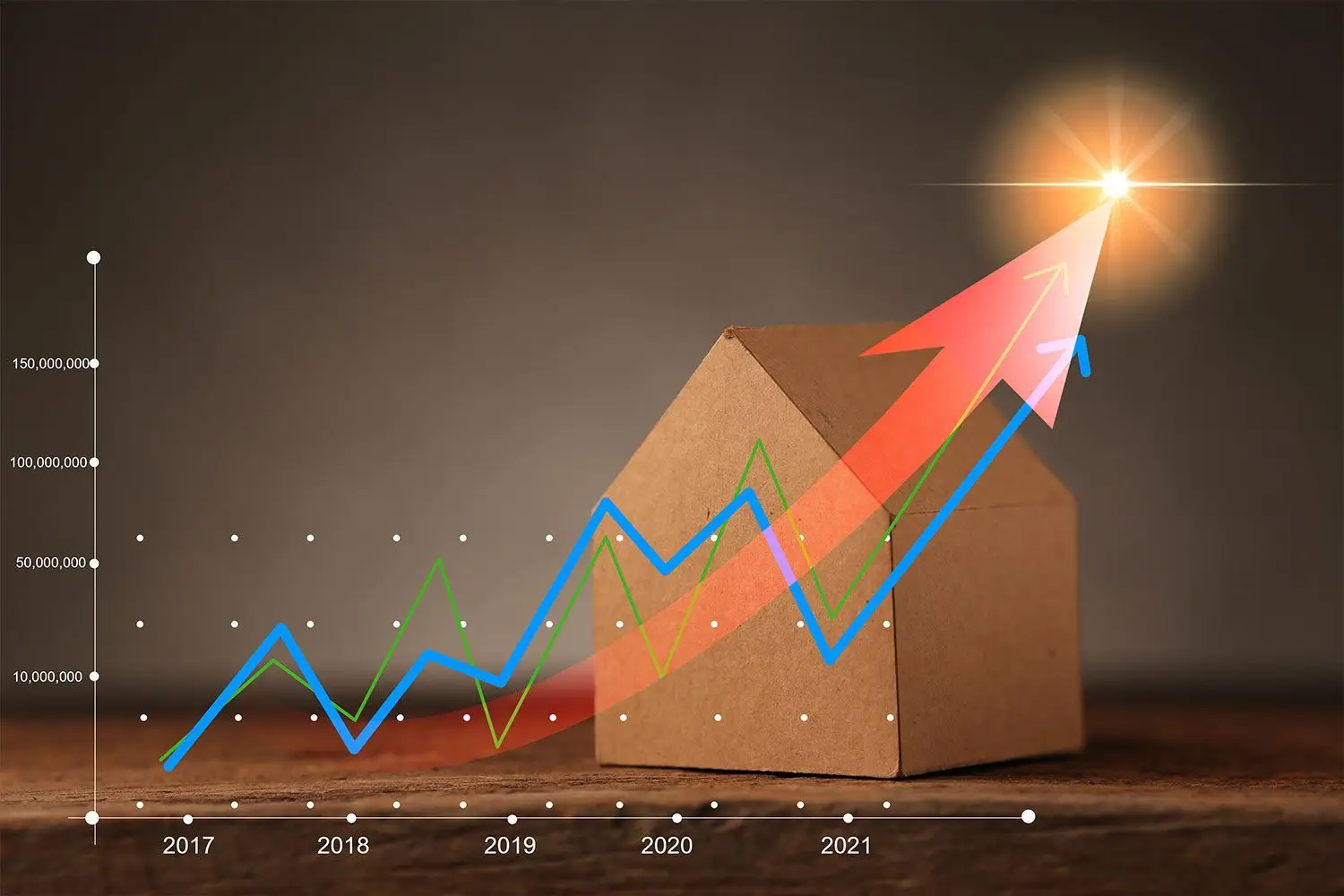Are you looking to buy a home but are put off by the high mortgage rates? You’re not alone! Home mortgage rates remain high relative to treasuries, leaving many potential home buyers frustrated and unable to take advantage of low rates.
In this blog post, we’ll explore why mortgage rates are high relative to treasuries and when they might start to fall. We’ll also provide helpful tips for how to take advantage of low rates now, so you can make your home-buying dreams a reality.
Table of Contents
Historical Standards of Mortgage Rates

In the past, mortgage rates have typically been higher than Treasury yields, with an average spread of 1.69 percentage points over all available data. For example, in February 2019, 10-year Treasury bonds yielded 2.68% while the average 30-year fixed rate mortgage cost 4.37%. This difference is right at the long-term average of 1.69%. Generally, this spread ranges between 1.5% and 2.0%.
The spread can be explained by the role of the mortgage originator who negotiates an interest rate between the home buyer and the lender.
Mortgage originators are paid a fee for their services in the form of a cash equivalent that is factored into the interest rate, often referred to as the retail mortgage spread.
For instance, in the first week of 2020, the average mortgage interest rate was 3.72%, while Fannie Mae’s average interest rate paid to investors was 2.61%, leaving a spread of 1.11% for the mortgage originator’s services.
What do Investors Think?
Investors view mortgage bonds as less secure than treasury bonds, as homeowners can refinance when interest rates drop, forcing investors to reinvest their cash at lower rates. This is why mortgage rates remain higher than treasury rates – investors need to be compensated for the additional risk they take.
However, with the economy showing signs of improvement and mortgage rates beginning to fall, investors may become more willing to purchase mortgage bonds again. As such, mortgage rates could start to fall further in the coming weeks as the economy continues to improve, providing a much-needed relief for homeowners.
The Option for Homeowners
Refinancing your home mortgage can be smart, especially in times of high-interest rates. It allows homeowners to reduce their monthly payments and lower the overall interest rate on their loans. Refinancing your mortgage can also help you repay your loan faster, build equity, and even save money in the long run.
However, it’s essential to consider how much premium investors demand mortgage-backed securities over treasuries before refinancing your home mortgage. If mortgage rates remain too high relative to treasuries, you may need more time and effort to afford your home loan.
The Federal Reserve has been buying mortgage-backed securities for the last few years to help keep interest rates low. However, since the Fed is now tapering its bond purchases, mortgage rates have started to rise. That being said, they have still remained lower than treasuries.
If you’re considering refinancing your home loan, compare current research rates to what treasuries offer. You can use online calculators to get an idea of how much you could save if you were to refinance your loan. Once you have determined that the interest rates are lower than treasuries, refinancing your loan may be worth it.
In addition, mortgage rates have already started to fall in recent weeks. They are likely to fall further as the economy continues to improve. This could mean an even more incredible opportunity for homeowners to refinance their mortgages and benefit from lower monthly payments. Therefore, homeowners must stay informed about market conditions and take advantage of opportunities.
Retail & Wholesale Spread
Retail spread is the difference between the interest rate a consumer pays on their mortgage loan and the interest rate a lender receives from the secondary mortgage market or investor. It is also called the “origination” or “margin” spread. This is the money that a lender makes for originating the loan and is usually added to the rate that the borrower pays. In today’s low-interest-rate environment, lenders must make more money off each loan to stay profitable, often adding additional points to the interest rate.
Wholesale spread is the difference between the average rate at which lenders issue mortgages and the rate at which they sell them in the secondary mortgage market. It is also known as the “secondary market” spread. This spread has been volatile over time and widened considerably in 2020. The primary reason for this was that lenders were overwhelmed with refinancing applications and had to raise their prices to keep up with demand.
In conclusion, the retail and wholesale spreads widened considerably in 2020 due to increased demand for mortgage refinancing. This means homeowners are paying higher rates for their mortgages than Treasury rates. However, when demand decreases, these spreads should start to shrink, leading to lower mortgage rates for borrowers.
Mortgage Rates and Treasury Bonds
The current difference between mortgage rates and Treasury bonds is wider than historical standards. This discrepancy is due to the difference in the wholesale level of mortgage rates and the retail level of mortgage rates. It is estimated that the spread between the two levels is around 0.8%. The spread between retail mortgage rates and 10-year Treasury bonds is even higher at an estimated 1.2%.
Investors have become increasingly cautious about mortgage-backed securities due to their vulnerability to interest rate volatility. Rising interest rates cause fewer mortgage prepayments, making them less attractive investments. Falling interest rates cause more prepayments, which can hurt investors’ returns. This fear of rising and falling interest rates has caused investors to be warier about investing in mortgage-backed securities, driving up the cost of mortgages relative to treasury bonds.
This increased spread means higher mortgage rates and more expensive borrowing costs for homeowners. While the Federal Reserve has kept the federal funds rate near zero, mortgage rates remain high. This means that homeowners must pay a premium if they want to borrow.
However, suppose the Federal Reserve maintains low-interest rates and the economic recovery continues. In that case, mortgage rates will likely fall as well. As investor confidence increases and the spread narrows, we could see mortgage rates start to match or fall below Treasury bond rates.
Volatility of Mortgage Rates
Mortgage rates are typically higher than treasury bonds because of the additional risk associated with home loans. At the retail level, this is due to the risk taken by mortgage originators when providing interest rate quotes to potential borrowers.
The volatility of mortgage rates has also been increasing in recent times. Over the last 52 weeks, the standard deviation of the absolute value of weekly rate changes doubled compared to the preceding period.
This increase in volatility is primarily attributed to the uncertain economic environment created by the pandemic, with investors unsure of the direction of rates shortly.
As a result, mortgage originators are factoring in an additional risk premium for the uncertainty and unpredictability when offering interest rate quotes to prospective borrowers. This is why home mortgage rates remain high relative to treasuries even though treasury bond yields have declined recently.
However, this situation may change if there is more certainty in the markets and interest rates fall again. This could lead to a decrease in mortgage rates, which would be beneficial to potential homeowners.
When does this widespread return to normal?
The spread between home mortgage rates and Treasury bond rates will return to normal when the Federal Reserve finishes its tightening cycle and eventually returns interest rates to a stable level. This is likely to occur sometime in 2024.
At that point, the spread between home mortgage rates and Treasuries should narrow as investors become more confident about future interest rate stability.
Homeowners looking to refinance or purchase a home should keep an eye on the Fed’s rate policies as it could affect their ability to secure favourable mortgage rates.
Home Buyers Prospectives
For prospective home buyers, the Fed’s decision on whether or not to ease may have an effect on the actual mortgage rate they are looking at. While the spread between mortgage rates and Treasuries may remain wide, if the Fed begins easing, mortgage rates could fall in anticipation of that easing.
Those looking to refinance or take out a new mortgage loan will want to pay close attention to the Fed’s decisions and how other factors, such as the economy and financial markets, may affect mortgage rates. When the spread between Treasuries and mortgages returns to normal, mortgage rates could experience even greater downward pressure.
At present, most economists and market analysts believe that mortgage rates will gradually start to fall early in 2024 and continue for two years or so, with the most significant declines coming after the Fed has begun easing.
Prospective homebuyers need to remember that their actual mortgage rate could be affected by many other factors besides the Fed’s decision on whether or not to ease. These include their credit score, the type of loan they are seeking, and any special loan programs they may qualify for.
Final Words
When it comes to home mortgage rates, understanding the impact of treasury bonds and retail and wholesale spreads is critical. With the current volatility of mortgage rates, there is no definitive answer as to when this widespread will return to normal. While investors are uncertain of the future, homeowners still have the option to invest in a low-interest rate mortgage.
At the same time, they wait for market conditions to improve. Homebuyers should stay informed on the market’s current state and take advantage of the best interest rate options available to them. By researching and staying up to date with current trends, homebuyers can make an educated decision on their mortgage rate and ensure they get the best possible deal.























